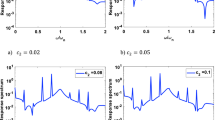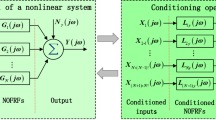Abstract
Most of the dynamic systems are inherently nonlinear either with stiffness nonlinearity or with damping nonlinearity. Presence of nonlinearity often leads to characteristic behaviours in response such as jump phenomenon, limit cycle and super-harmonic resonances. Such behviours can be accurately predicted only if the nonlinearity structure and related parameters are properly known. A majority of identification works is based on a-priori knowledge of nonlinearity structure and most of them consider only stiffness nonlinearities. Not much work has been reported on identification and parameter estimation in the area of damping nonlinearities. This paper presents a systematic classification of asymmetric damping nonlinearity and develops a parameter estimation algorithm using harmonic excitation and response amplitudes in terms of higher order Frequency Response Functions. The asymmetry in damping nonlinearity is modeled as a polynomial function containing square and cubic nonlinear terms and then Volterra series is employed to derive the response amplitude formulation for different harmonics using synthesied higher order Frequency Response Functions. Detailed numerical study is carried out with different combinations of square and cubic nonlinearity parameters to investigate appropriate excitation level and frequency so as to get measurable signal strength of second and third harmonics and at the same time keeping the Volterra series approximation error low. The estimation algorithm is first presented for nonlinear parameters and then it is extended for estimation of linear parameters including damping ratio. It is demonstrated through numerical simulation that nonlinear damping parameters can be accurately estimated with proper selection of excitation level and frequency.





















Similar content being viewed by others
References
Nayfeh AH, Mook DT (1979) Nonlinear oscillations. Willey, New York
Nayfeh AH (1985) Parametric identification of nonlinear dynamic systems. Comput Struct 20:487–493
Bendat JS, Palo PA, Coppolino RN (1992) A general identification technique for nonlinear differential equations of motion. Probab Eng Mech 7:43–61
Tiwari R, Vyas NS (1995) Estimation of nonlinear stiffness parameters of rolling element bearings from random response of rotor bearing systems. J Sound Vib 187(2):229–239
Rice HJ, Fitzpatrick JA (1991) The measurement of nonlinear damping in single-degree-of-freedom systems. J Vib Acoust 113:132–140
Balachandran B, Nayfeh AH, Smith SW, Pappa RS (1994) On identification of nonlinear interactions in structures. AIAA J Guid Control Dyn 17(2):257–262
Khan KA, Balachandran B (1997) Bispectral analyses of interactions in quadratically and cubically coupled oscillators. Mech Res Commun 24(5):545–550
Bikdash M, Balachandran B, Nayfeh A (1994) Melnikov analysis for a ship with general roll damping. Nonlinear Dyn 6:101–124
Balachandran B, Khan KA (1996) Spectral analysis of non-linear interaction. Mech Syst Signal Process 10(6):711–727
Volterra V (1958) Theory of functionals and of integral and integro-differential equations. Dover Publications Inc, New York
Schetzen M (1980) The Volterra and wiener theories of Nonlinear Systems. Wiley, New York
Chatterjee A, Vyas NS (2003a) Non-linear parameter estimation with Volterra series using the method of-recursive iteration through harmonic probing. J Sound Vib 268:657–678
Chatterjee A, Vyas NS (2003b) Nonlinear parameter estimation in rotor-bearing system using volterra series and method of harmonic probing. J Vib Acoust 125:299–304
Peng J, Tang J, Chen Z (2004) Parameter identification of weakly nonlinear vibration system in frequency domain. Shock Vib 11:685–692
Peng ZK, Meng G, Lang ZQ, Zhang WM, Chu FL (2012) Study of the effects of cubic nonlinear damping on vibration isolations using harmonic balance method. Int J Non Linear Mech 47:1073–1080
Ho C, Lang ZQ, Billings SA (2014) A frequency domain analysis of the effects of nonlinear damping on the Duffing equation. Mech Syst Signal Process 45:49–67
Zhang B, Billings SA (2017) Volterra series truncation and kernel estimation of nonlinear systems in the frequency domain. Mech Syst Signal Process 84:39–57
Chatterjee A (2010) Identification and parameter estimation of a bilinear oscillator using Volterra series with harmonic probing. Int J Non Linear Mech 45:12–20
Cveticanin L (2011) Oscillators with nonlinear elastic and damping forces. Comput Math with Appl 62:1745–1757
Detroux T, Renson L, Kerschen G (2014) The harmonic balance method for advanced analysis and design of nonlinear mechanical systems. Nonlinear Dyn 2:19–34
Jones JCP, Yaser KSA (2018) Recent advances and comparisons between harmonic balance and Volterra-based nonlinear frequency response analysis methods. Nonlinear Dyn 91:131–145
Noel JP, Kerschen G (2017) Nonlinear system identification in structural dynamics: 10 more years of progress. Mech Syst Signal Process 83:2–35
Elliott SJ, Tehrani MG, Langley RS (2015) Nonlinear damping and quasi-linear modelling. Philos Trans R Soc A Math Phys Eng Sci 373:20140402
Shum KM (2015) Tuned vibration absorbers with nonlinear viscous damping for damped structures under random load. J Sound Vib 346:70–80
Habib G, Cirillo GI, Kerschen G (2018) Isolated resonances and nonlinear damping. Nonlinear Dyn 93:979–994
Adhikari S, Woodhouse J (2001) Identification of damping: part 2, non-viscous damping. J Sound Vib 243(1):43–61
Rajalingham C, Rakheja S (2003) Influence of suspension damper asymmetry on vehicle vibration response to ground excitation. J Sound Vib 266:1117–1129
Silveria M, Wahi P, Fernandes JCM (2019) Exact and approximate analytical solutions of oscillator with piecewise linear asymmetrical damping. Int J Non Linear Mech 110:115–122
GhandchiTehrani M, Elliott SJ (2014) Extending the dynamic range of an energy harvester using nonlinear damping. J Sound Vib 333:623–629
Chatterjee A, Chintha HP (2020) Identification and parameter estimation of cubic nonlinear damping using harmonic probing and volterra series. Int J Non Linear Mech 125:103518
Ewins DJ (1984) Modal testing: theory and practice. Research Studies Press, Baldock
Author information
Authors and Affiliations
Corresponding author
Ethics declarations
Conflict of interest
On behalf of all authors, the corresponding author states that there is no conflict of interest.
Additional information
Publisher's Note
Springer Nature remains neutral with regard to jurisdictional claims in published maps and institutional affiliations.
Rights and permissions
About this article
Cite this article
Chatterjee, A., Chintha, H.P. Identification and Parameter Estimation of Asymmetric Nonlinear Damping in a Single-Degree-of-Freedom System Using Volterra Series. J. Vib. Eng. Technol. 9, 817–843 (2021). https://doi.org/10.1007/s42417-020-00266-7
Received:
Revised:
Accepted:
Published:
Issue Date:
DOI: https://doi.org/10.1007/s42417-020-00266-7




